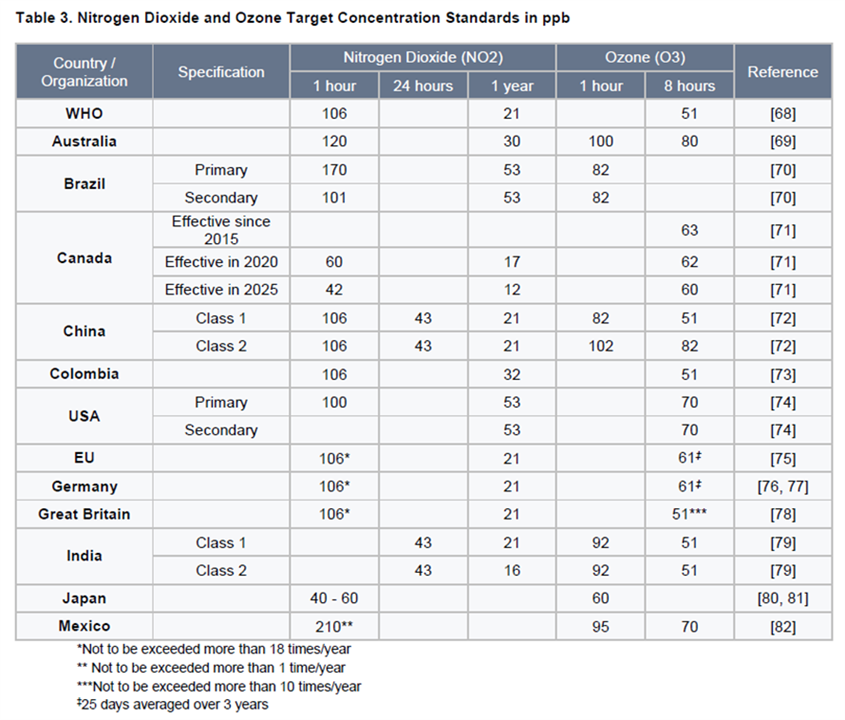Challenger - ZMOD4510 - Outdoor Air Quality Sensor
Hello element14 Family,
We may better comprehend the amounts of air pollution exposure that are harmful to human health by looking at the following table from the Renesas whitepaper. Regarding the noise exposure levels, the NIOSH Recommended Exposure Limit (REL) for occupational noise exposure is 85 decibels, A-weighted, as an 8-hour time-weighted average (85 dBA as an 8-hr TWA) using a 3-dB exchange rate. Exposures at or above this level are considered hazardous (similarly, we can also take into account the non-work exposures standards as well).
Thus, the portable device and the mobile app dashboard can aid in our understanding of our individually tailored exposures.

In addition to the contents of Summer of Sensors Design Challenge - In The Air Tonight – Blog #1 (Problem Statement), the following statements might reiterate why such a device might be important:
- It has been observed that a 10ppb ozone increase causes a 0.52% increase in daily mortality and a 0.64% increase in cardiovascular and respiratory mortality
- A 2017 study by the Institute of Global Health among 2700 children in Barcelona (Spain), concluded that pollution, especially NO2 and elemental carbon, affects the ability of children to attend school in the short term, delaying the speed of class responses
- In Europe, 61,000 DALYs (disability adjusted life years lost) were attributed to ischaemic heart disease based on hypertension and IHD outcomes, 45,000 DALYs to cognitive impairment in children and young people, aged 7–19 years, 903,000 DALYs to sleep disturbance for people living in towns with more than 50,000 inhabitants, 22,000 DALYs to tinnitus, and 654,000 DALYs for annoyance – underscoring the impact of noise pollution.
In the modeling of noise and air pollution, exposure misclassification is a significant source of mistake. The effects of people moving throughout the exposure period of the research are frequently not taken into consideration, the length of exposure may not be precisely quantified, and exposure to many sources of noise, particularly extra occupational exposure, may not be adequately accounted for. Many studies make the assumption that people stay at home all day, which might result in exposure misclassification.
Hence, two key challenges arise for a real-time monitoring solution:
- The closeness to the source, the length of exposure, and the multiple microenvironments where someone spends their time should all be taken into account when calculating total personal exposure. Individuals who ride buses and drive vehicles, for instance, are often exposed to greater levels of pollution than people who walk or bike, yet faster breathing rates while bicycling and walking may result in greater amounts of pollutants being absorbed.
- Metal Oxide sensors, like other inexpensive gas sensors, have limited selectivity, which means they are susceptible to a variety of airborne contaminants. Humans may release a variety of gases through their natural skin oils, cosmetics, fabrics, and breathing, and when sensors are put close to the human body, these gases may interfere with readings of the ambient air pollutants (e.g., on wristbands, attached to belts or backpacks).
So, how can we approach our final real-time monitoring solution?
- To map the duration and intensity of exposure, integrate biosensors (like those from the Under Pressure Challenge) into monitoring (or utilize the data already being collected by wearables like smart watches).
- As human interference leads to an increase in the concentration of VOCs, an edge deployed neural network calibration framework trained on samples from gas sensors with different cross sensitivities to address the non-linear effects.
As a result, I'm eager to upgrade the developed device with the aforementioned capabilities (biosensors + tensorflow Lite + BLE communication) and will keep the element14 community informed of my progress.
Please accept my sincere gratitude for reading my Summer of Sensors Design Challenge blog series until then
